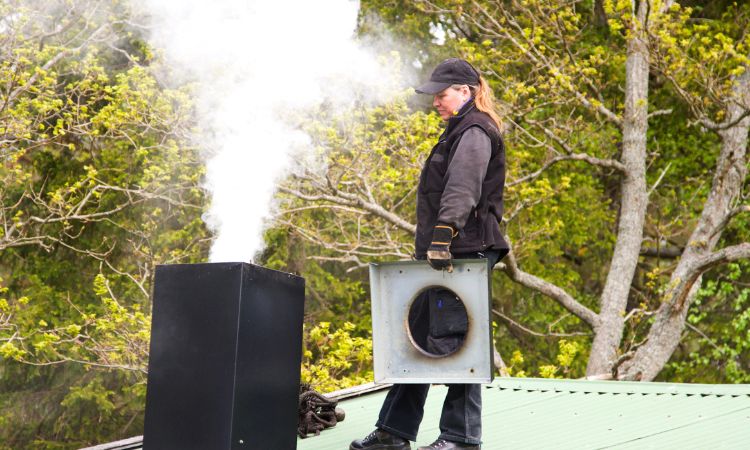Chimney Repair El Paso, TX
Call for a Quote
(915) 266-0067
All Services
Chimney Repair: Fixing Common Chimney Issues
Your chimney is one of the most important components of your home’s heating system, providing a safe outlet for smoke and gases to escape when you use your fireplace or stove. But over time, even the most well-maintained chimneys can experience wear and tear. Cracked bricks, deteriorating mortar, and broken chimney liners are just a few of the common issues that can develop. If left unaddressed, these problems can compromise the safety and efficiency of your entire chimney system. In this post, we’ll explore some of the most common chimney problems that homeowners face, why they occur, and how professional chimney repairs can help restore the integrity of your chimney system—keeping your home safe and warm for years to come.
Common Chimney Issues and Why They Happen
- Cracked or Damaged Chimney Liner
The chimney liner is a crucial part of your chimney system. It helps protect the inner walls of the chimney from the high heat generated by burning fuels, and it also keeps dangerous gases, such as carbon monoxide, from escaping into your home. Over time, however, chimney liners can crack, become corroded, or even collapse, especially if they are made from clay or are subject to extreme temperature fluctuations. Why It Happens: Age, temperature extremes, and the expansion and contraction of the liner materials can weaken the liner over time. Poorly vented fireplaces or stoves can also contribute to the deterioration of the liner. - Damaged or Deteriorating Mortar
Mortar holds the bricks of your chimney together. If the mortar begins to crack, crumble, or wash away, it can compromise the stability of the entire chimney structure. This is especially common in older chimneys that have been exposed to years of weathering.Why It Happens: Moisture is the primary culprit in mortar deterioration. Over time, rainwater, snow, and ice can seep into the mortar, causing it to freeze and thaw repeatedly, which weakens its integrity. Chimneys that lack proper waterproofing are especially prone to this problem. - Chimney Leaks
Chimney leaks can occur when water gets into the chimney structure, often through the crown or the flashing. Water infiltration can cause significant damage to the brickwork, mortar, and chimney liner. In some cases, leaks can also lead to rust and corrosion in metal components like the chimney cap, damper, or firebox. Why It Happens: Leaks are often caused by damaged flashing (the seal around where the chimney meets the roof), cracked chimney crowns (the concrete cap at the top of the chimney), or worn-out chimney caps. If water is able to enter the chimney, it can quickly lead to costly damage. - Cracked or Missing Chimney Cap
The chimney cap sits at the top of your chimney and serves several important functions: it prevents debris and animals from entering, keeps rainwater out, and helps maintain proper airflow. Over time, the cap can become damaged or corroded, especially if it’s made from a material like steel or copper.Why It Happens: Weather exposure (rain, snow, ice, and wind) can cause the chimney cap to degrade. If the cap is not maintained or replaced periodically, it can crack or become loose, allowing debris or animals to enter the chimney. - Soot and Creosote Buildup
When you burn wood or other fuel sources, a residue known as creosote forms and sticks to the interior walls of your chimney. If this buildup is not regularly cleaned, it can restrict airflow and create a fire hazard. In extreme cases, large amounts of creosote can ignite, causing a dangerous chimney fire.Why It Happens: Creosote is a natural byproduct of burning wood, and it builds up more quickly when burning green or softwoods, which create more smoke. Poor ventilation or improper burning techniques can also contribute to excessive creosote buildup.
The Importance of Timely Chimney Repair
Chimney repairs are not just about aesthetics; they are about keeping your home safe and your heating system running efficiently. Neglecting minor issues can lead to bigger, more expensive problems down the line. Here’s why timely chimney repair is so important:
- Fire Prevention
One of the most important reasons to repair your chimney is to prevent fires. Cracked liners, creosote buildup, and damaged chimney caps all increase the risk of a chimney fire. By addressing these problems early, you can significantly reduce the chances of a fire starting inside your chimney or fireplace. - Protect Your Home from Water Damage
Leaking water in your chimney can cause extensive damage, from rusting metal parts to eroding mortar and rotting wood. In extreme cases, water infiltration can even compromise the structural integrity of your entire chimney. Timely repairs can help seal leaks and prevent water damage from spreading throughout your chimney and into your home.

- Energy Efficiency
- Longer Lifespan of Your Chimney
chimney ensures that your fireplace or stove operates efficiently. If your chimney is clogged with creosote or if the liner is cracked, the flow of air may be restricted, making it harder for your fire to burn properly. This can lead to wasted energy, reduced heat output, and higher heating costs. Repairing these issues will help your chimney function at its best.
Like any other part of your home, your chimney has a lifespan. Regular repairs help extend the life of your chimney, preventing the need for expensive full replacements. Addressing issues like cracked liners, deteriorating mortar, and rusting components can keep your chimney in good condition for many years to come.
How to Know When Your Chimney Needs Repair
While some chimney issues are obvious (like a visible crack in the chimney liner or a missing cap), others may be more subtle. Here are some signs that it might be time to schedule a chimney repair: Visible Cracks or Gaps: Look for visible damage on the chimney’s exterior, including cracks in the bricks, missing mortar, or loose stones. Water Damage: If you notice stains on your chimney’s interior or exterior, it could be a sign of water infiltration. Look for rusting metal parts or crumbling mortar as well. Unpleasant Odors: A musty or smoky smell coming from your chimney could indicate mold, mildew, or soot buildup, which may require professional cleaning and repair.
Difficulty Lighting Fires: If your fireplace or stove is producing excessive smoke, or if you’re having trouble getting your fire to start, it could indicate a problem with airflow or a blockage in the chimney.
Excessive Soot or Creosote: If your chimney is producing a lot of soot or if you notice dark, oily stains inside the fireplace, it’s time for a cleaning and inspection.
Conclusion
Chimney repair is essential for maintaining the safety, efficiency, and longevity of your chimney system. From cracked liners to water damage and creosote buildup, neglecting these issues can lead to costly repairs and dangerous situations. By addressing chimney problems promptly and investing in regular repairs, you can enjoy the warmth and comfort of your fireplace without the worry of potential hazards.
If you notice any signs of damage or if it’s been a while since your last chimney inspection, don’t hesitate to contact a professional chimney repair technician. They can assess your chimney’s condition, perform necessary repairs, and ensure that your home stays safe and warm throughout the colder months.
